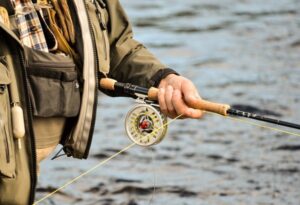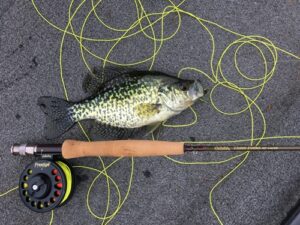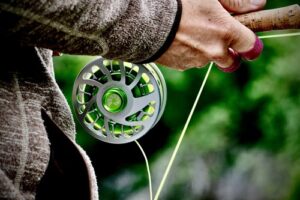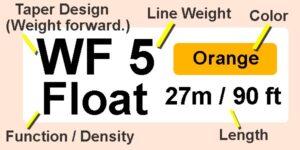How To Choose A Fly Line.
4 Things A Fly Fisherman Should Know About Fly Lines.

There are a huge variety of fly fishing lines available today to suit all fishing and conditions. So knowing how to choose a fly line is very important.
One item to consider is the fish you are after and their behavior and feeding habits. Like trout, bass and other species of fish feed in a wide variety of depths.
This range of food for the fish might be from terrestrial insects falling on the water surface, to crawfish deep down. So some fly lines are designed to float and others, to sink rapidly to the depths to cover the conditions.
To make matters more confusing, some lines are marketed that they have a unique taper design that may increase your casting ability. Also different weight lines are stamped on the packet. What is a 5 weight fly line? So selecting a fly line can be challenging.
So how do you choose a fly line and know it will be right for you? In this article we will cover the basic types of fly lines and learn about the different designs. Also how to choose a line right for you.

The 4 factors on how to choose a fly line.
Here are the four main items to take into consideration when choosing a fly line: 1. Weight, 2. Density and function, (Such as floating or sinking fly line.) 3. Line taper, 4. Color.
1. Fly line weight. What is a 5 weight fly line?
Fly fishing rods are built and designed to cast a certain fly line weight.
The weight of the fly line should match the weight of the rod.
As an example a 5 weight fly rod will work well with a 5 weight fly line.
The fly line weight is ranked from 1 to 15. One is the lightest and fifteen is the heaviest.
Generally the smaller rod / line weight are best for smaller fish.
For panfish a 4, 5 or 6 weight fly line might be selected.
With trout fishing you might use a fly rod / line weight from 5 to 7 weight. But this will depend on the general size of the fish and conditions. Such as small streams and spooky trout. Or large windy lakes, night fishing with monster trout.
A common question is, “What fly rod / line weight for bass?” For bass fishing, you might go a bit heavier, with 7 / 8 / 9 weight fly lines.
For bigger target fish species, a heavier weight line is used. Such as for saltwater fly fishing you might use an 8 weight rod / line, or a 12 weight rod and line depending on the size of the fish.
Weight of your fly line also can relates to the size of fly you use. Such as if you are casting small delicate flies, you might use a 4 weight line.
For bigger fly patterns and streamers, you might use a 7 or 8 weight or a heavier line / rod.
However with the correct leader and with some good technique, you can use a wide range of fly sizes and patterns. (I am not talking about casting a large marlin attractor with a 5 weight fly line and rod.)
For windier conditions, a heavier fly line might be used.
Fly rods and fly lines.
While matching the fly line weight to the fly rod weight is good advice, there are some other points to consider.
The exact weight fly line to use will depend on type of rod, such as some fly rods are designed stiffer than others.
Also an angler might like a slower rod feel or a responsive feel from the rod. This will depend on manufacture design, materials use, and weight of fly line.
Some rods might work well with a fly line one weight above or below the stated weight. Or even two weights above or below.
As an example a number 7 weight fly rod, might use a 6 weight fly line or even a 5 weight line.
Some advanced anglers might drop down a line weight or two when casting in calm conditions for timid trout. (It is easier to carry a spare line, then an extra different weight rod.)
Another point to consider is the quality of the fly line from the manufacturer. A cheaply made fly line will cast differently than a quality fly line (Style of line taper aside.)
Stick to the well-known brand manufacturers that have been making fly lines for years, like; Scientific Anglers, Rio Fly Lines, Airflo, etc.
In choosing a fly line weight ideally you might know: What fish species are you targeting? What fly are you casting? Will you be making a delicate dry fly presentation, or slogging saltwater flies in windy conditions?
If you are not sure what size fish and type around your fishing area, the local fishing shops near you or bait and tackle shop will give you some advice.
Fly fishing forums are other good places for information about you fishing waters.
Although for a start, stick with the recommended weight when buying the rod.

2. Fly line density and function.
What type of fly line should I use?
Let’s go over the function, or density of the fly lines. They are generally floating, intermediate, sink tip and sinking fly lines.
Let’s start first with the floating fly line and some positives and negatives of the design.
The floating line is the top choice for general fishing conditions for most streams and lakes. For beginners to fly fishing, a floating line is a good start.
Because a floating line actually has a multiple of uses and a very versatile fly line. You can use a floating fly line when fishing with dry flies on the surface. As well as nymphs and streamers from just below the surface, to the deep waters of the lake.
The floating fly line by itself, as the name suggests floats. The leader, tippet and fly tied to it, will eventually sink it. (Unless you put a floatant on the leader, tippet and fly.)
But floating lines have their limitations.
How deep you can fish with the floating line is dependent upon the length of the leader, the weight of the fly and the fisherman’s patience.
If you do want to fish a bit deeper with a floating fly line, you can within reason, use weighted flies and split shot on the line. This can help get down the line quicker and deeper, but it still has it’s limitations for deep fishing.
What is a sinking fly line?
Sinking fly lines have an outer coating on the fly line and they sink. They have different designs and ratings on how fast they sink. Such as the line will sink so many inches deep, per second.
If you are fishing very deep waters, you need a fast sinking line.
There are many varieties and some are labelled differently. The description below will give you a rough idea of their qualities and properties, depending on manufacture.
The intermediate fly line.
An intermediate fly line will sink slowly. It is similar properties to normal fishing line. Some manufactures make them clear, or translucent like fishing lines.
It can also be used for saltwater fishing as well, in shallow calmer conditions. As it will sink below the waves and won’t be affected by the waves as much. Say, compared to if it floating fly line on the surface.
Sinking tip fly lines.
Sinking tip lines are designed so that just the mainly the front section, or tip of the line will sink.
Slow sinking lines.
A slow sinking fly line sinks about 1 to 2 inches per second, depending on the manufacturer’s design. Also if you have a weighted fly and a short leader, this combination will make it sink faster.
This fly line is a good selection for shallow to medium depths of water because of the slower sinking rate of the line. With the use of a sinking line the amount of time you have to wait for the fly to sink is decreased, as opposed to an intermediate line.
Fast sinking fly line.
The fast sinking fly line sinks about 3 to 5 inches per second or more. You can get a variety of degrees of sinking lines, depending on the brand; some are medium slow to ultra fast sinking. This type of fly line is perfect for fishing in the drop-off area of the lake or from boats.
On hot days, trout like to occupy these drop-offs because of the cooler water temperature closer to the bottom. This can be very important to the trout during the warm summer months. The plants in most drop-off areas are still photosynthesizing, so the plants are still growing making for the abundance of insect or fish food.
The use of the fast sinking fly line makes more sense if your species of fish is active deep down.
You want to make sure that you are retrieving your line as close to the bottom as possible. So you will need to do some calculating.
Count the time it takes for the fly to reach the bottom using the specifications on the package. This will help you know when you should retrieve your line, however, if you are constantly getting snagged on the vegetation at the bottom, you will want to wait less time before retrieving your fly line.
A negative for fishing sinking fly lines as they are hard to pull out of the water to re-cast the line.
Sinking or floating line, for the beginner?
For a beginner a floating line should be fine for general conditions, from lakes, ponds and rivers. If you are fishing very deep waters and your target fish species is deep down, a sinking line might be considered.
Some angler may have a floating fly line on their rod for general fly fishing. In their vest the might have a spare spool with a sinking fly line set up with a leader and tippet. For fishing deep waters or where the fish are feeding down low.
3. Fly line taper design.
Fly lines have a design, or taper that helps them cast the line out, and roll, or present the fly delicately.
There are various tapers to choose from and they use various abbreviations such as, “WF” which stands for weight forward taper.
The weight forward taper or WF fly line.
The “WF” fly line has a taper with some weight on the end of the line to help it cast the fly out. It used for fishing nymphs, wet flies, streamers and dry flies, depending on the fly line weight and leader set up, etc.
A weight forward line is also good for windy conditions and shoots out easier.
The double taper fly line.
The double taper line is called a “DT” line, is designed to be tapered at both ends. It has been used for a number of years as a general fly line. It is good for dry flies as the delicate way (It depends on the caster.) it lands the fly.
Another advantage of the double taper line is, if one end is worn out, you can just swap the fly line about and use the unused end.
One negative of the double taper fly line is it won’t cast as easily, or far for the beginner fly fisherman.
The BBT or Bass bug taper fly line.
This line is similar to a weight forward fly line and it help cast bigger and heavier flies for bass fishing.
Other fly lines tapers.
There are also other variations of fly lines, such as a triangle taper and other designs for different conditions and targeting saltwater fish.
A “Level” line is used for steelhead, or blue-water fishing from boat or shore. It is a specialty distance type of line. It is used as running line for shooting heads. Shooting heads with lead cores can be very heavy.
With other designs you can get a combination of line tapers, different diameters and where the taper starts from.
Which fly line for the beginner? What taper line?
A weight forward fly line is probably best for the beginner. As it can help load up the rod and shoot the line out. You can get a feel for the rod and its action with a “WF” taper and it helps with windy days.
4. Fly line colors.
You can also get a wide variety of colors in a fly line. The colors range from high visibility fluorescent lines, clear ones, to dull and camouflaged fly lines.
Some anglers like a floating line that is a light color, like cream or an off white. As the thinking is, when a fish is looking up from the bottom or mid waters, the lighter color fly line will blend in more and be harder to see with the bright surface.
Likewise a darker line can be harder to see if the fish is looking down, or sideways at the line. So a dark color might be chosen for sinking lines.
For beginners a bright orange, yellow, pink or white fly line might be a good choice, so it is easy to see. This helps when learning and watching your casting.
Also a bright line is easier to see on the water floating, as you can see if the line has any drag, or movement if a fish takes the fly.
Fly line packaging, what does the label mean?

Above image. Your fly line might come with a label, similar to above. The “WF” is weight forward taper. The number “5” is the fly line weight. Color should match the color of line in the packaging. The “Float” is the function, such as sink, float etc. And the numbers in the bottom right corner are the length of the fly line.
Conclusion – How to choose a fly line.
A fly line design consists of four main aspects; 1. line weight, 2. density / function, 3. taper and 4. color.
Knowing about the four factors when learning how to choose a fly line is very important. As you can match the type of fly fishing equipment, to the fish species and water conditions you fish in.
Happy fishing.
